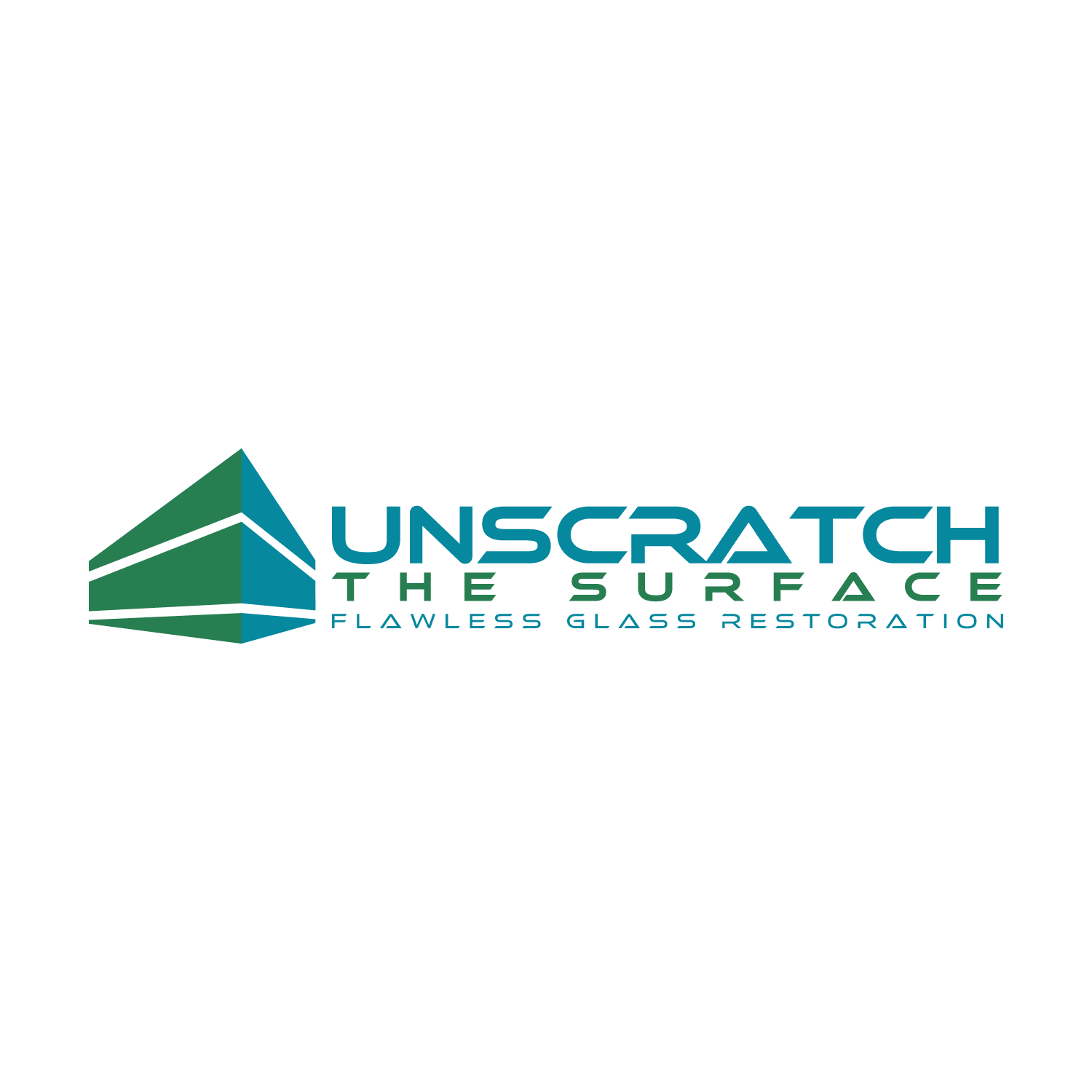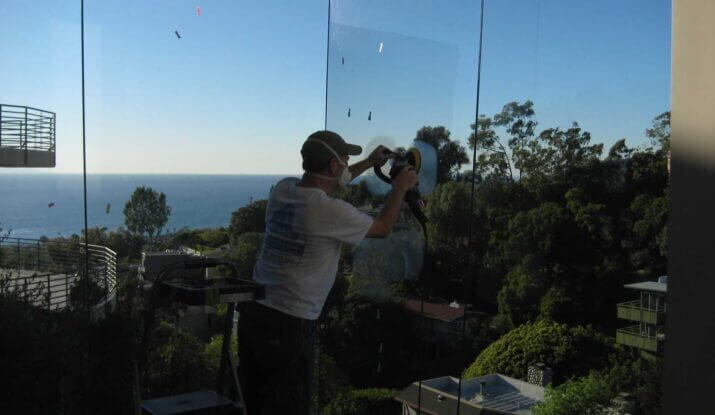Table of Contents
The Shocking Truth About Window Waste vs Glass Restoration in America
Every year, a staggering amount of perfectly good glass ends up in U.S. landfills instead of being restored or recycled. The numbers are jaw-dropping – over 12 million tons of glass waste generated annually, with only a third being recycled. Is there a cost effective way to restore scratched glass?
The rest? A whopping 7.55 million tons of repairable glass gets needlessly discarded and replaced. That’s enough to fill two Empire State Buildings with bottles and jars alone! This massive glass waste isn’t just an environmental catastrophe – it’s an economic one too.
Replacing large commercial windows, glass installations, or building facades can be costly, often running into hundreds of thousands of dollars, making restoration a financially prudent option. Yet professional glass restoration and resurfacing services like Unscratch the Surface can restore scratched glass, even severely damaged, scratched, etched or stained glass for a fraction of replacement costs.
The Sustainable Solution: Glass Restoration
While replacing glass has been the knee-jerk reaction, a revolutionary industry is gaining momentum – professional glass restoration and resurfacing. Companies like Unscratch the Surface use advanced techniques like diamond abrasives, specialized polishing compounds, and protective coatings to repair and restore:
- Scratches
- Etchings
- Stains and other blemishes on a piece of glass can often be completely removed through professional restoration work, preserving the aesthetic and value of original windows.
- Graffiti
- Other damage
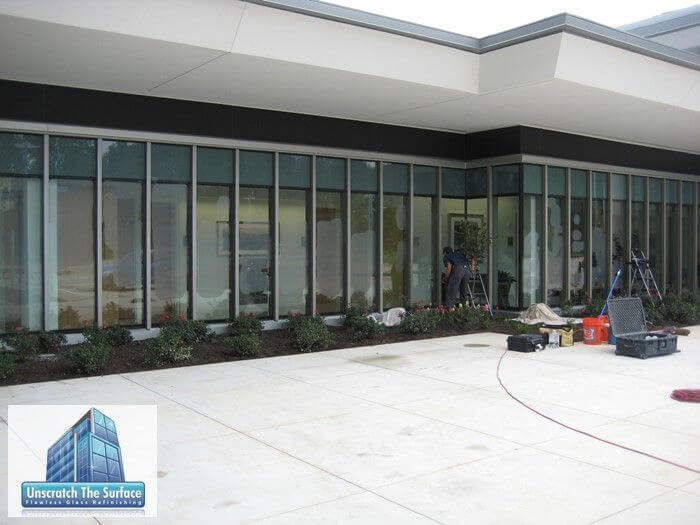
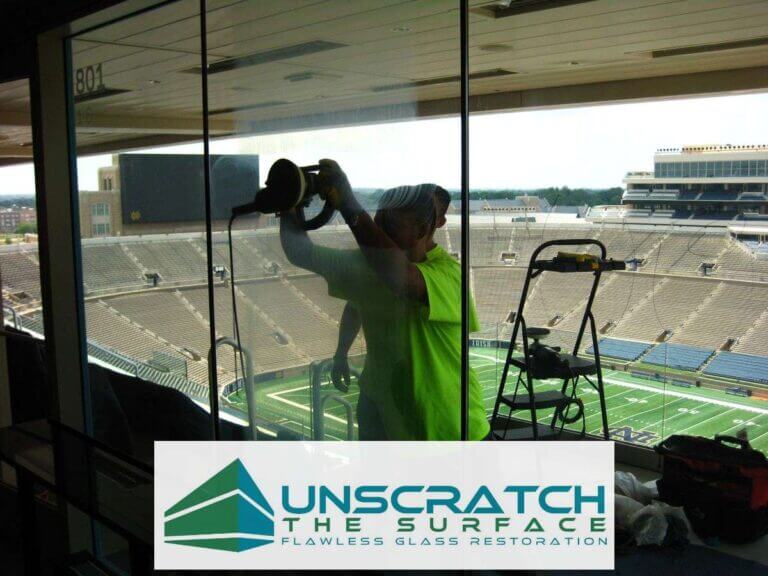
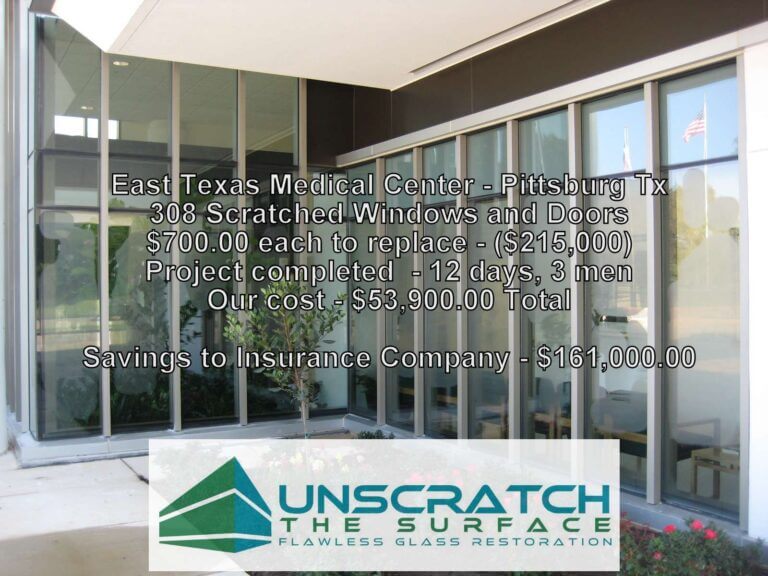
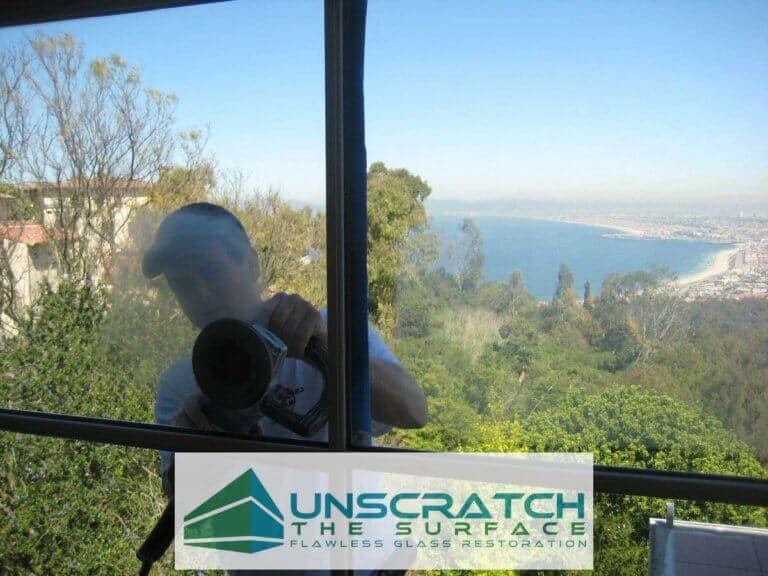
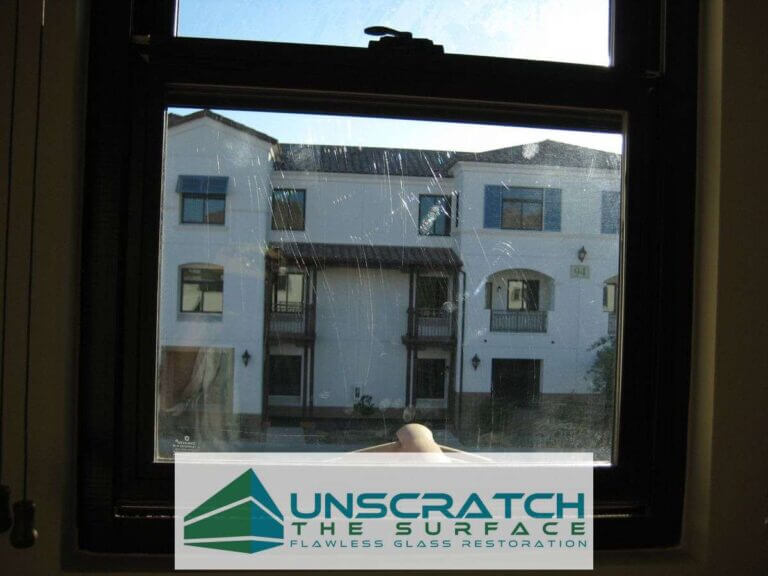
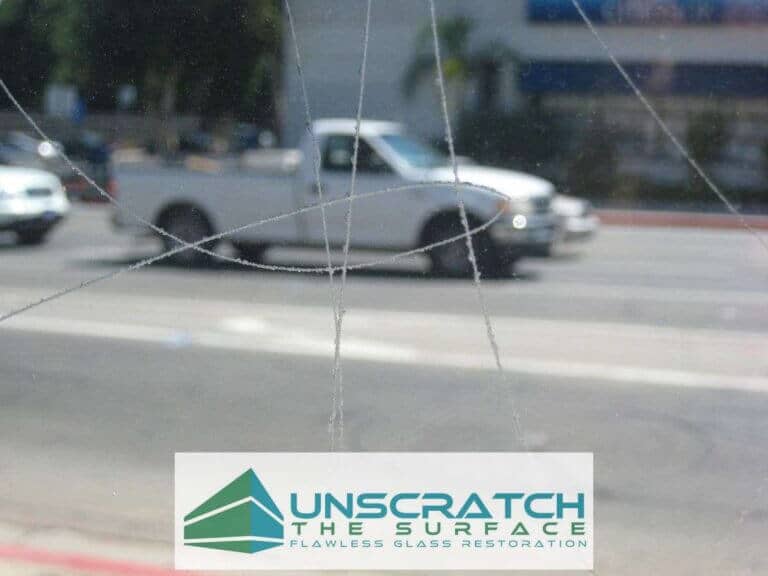
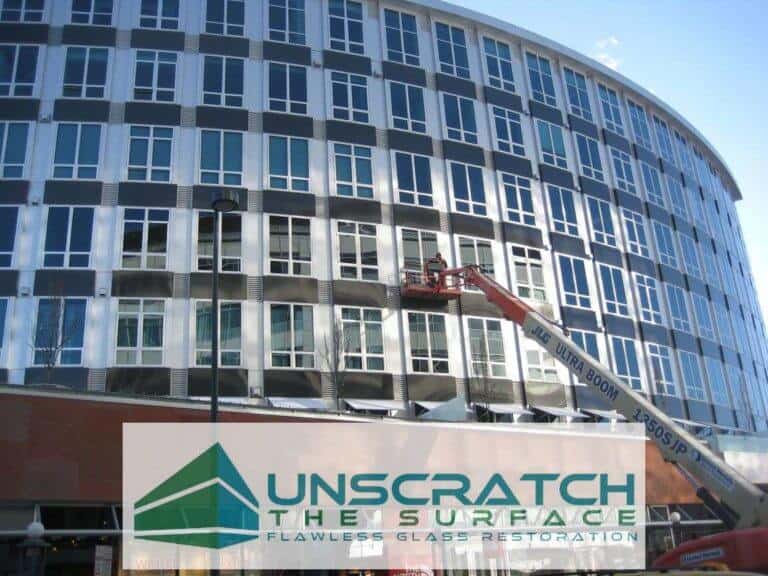
Their patented glass refurbishment processes can restore glass surfaces to pristine, like-new condition while preventing millions of tons of reusable glass can be saved from landfills with effective restoration projects, emphasizing the environmental benefit of preserving original windows. from ending up in landfills annually. This supports a circular economy by maximizing the lifespan and reuse of existing glass rather than downcycling it. Their innovative techniques also contribute to the conservation of energy and resources by reducing the need for new glass production. In addition to the environmental benefits, their work also helps to preserve the fascinating glass production history by retaining the integrity and authenticity of original glass windows and surfaces. By choosing glass restoration over replacement, individuals and organizations can contribute to the preservation of both the environment and the cultural heritage associated with these timeless materials.
For example, Unscratch the Surface recently completed a glass resurfacing project at the iconic Notre Dame Stadium in South Bend, Indiana. They restored 8,500 sq ft of severely scratched tempered glass – preventing a whopping 42 tons of repairable glass from being landfilled or downcycled into lower-value products.
Cost Savings & Sustainability Win-Win
Beyond the massive environmental benefits of reducing glass waste, professional glass restoration provides a remarkable cost-saving solution over full replacement. The numbers speak for themselves: In many cases, repairing damaged glass through professional services can be up to 70% cheaper than replacing an entire pane or window. Glass scratch repair is a precise and effective method that not only restores clarity but also extends the life of the glass. This sustainable approach significantly reduces the demand for new raw materials, reinforcing its economic and environmental advantages. Additionally, the cost of scratched glass repair is often far more manageable than the expenses associated with sourcing and installing new glass. By choosing restoration over replacement, homeowners and businesses can allocate their resources more effectively, directing savings towards other important projects or improvements. Ultimately, investing in professional glass restoration not only benefits the environment but also proves to be a financially savvy choice.
| Project | Replacement Cost | Restoration Cost | Savings |
|---|---|---|---|
| Notre Dame Football Stadium | $1,000,000 | $153,000 | 42 tons of glass saved |
| East Texas Medical Center | $215,000 | $53,900 | $161,000 saved for insurance |
As these real-world case studies show, glass restoration routinely saves clients 70-85% compared to replacement costs for large commercial projects. It’s a win-win – drastically reducing environmental waste and expenses.
The glass resurfacing, repair, and refinishing processes used by Unscratch the Surface and others allow the original embodied energy and resources that went into manufacturing the glass to be preserved rather than wasted. This supports sustainability goals while providing significant cost savings.
Overcoming Glass Recycling Obstacles
While glass is 100% recyclable in theory, lack of proper recycling infrastructure, economics, and glass quality requirements present major challenges in practice. Key obstacles to higher recycling rates include:
- Lack of recycling facilities: Many municipalities have stopped accepting glass for recycling due to high processing costs.
- Single-stream contamination: Broken glass mixing with other recyclables renders entire streams non-recyclable.
- Consumer awareness: Many don’t realize the environmental benefits of recycling over landfilling glass.
- Transportation costs: Glass is heavy, so freight costs often make hauling it long distances for recycling uneconomical.
- Sorting/cleaning expenses: Separating glass by color and removing contaminants adds costs that landfilling avoids.
Professional glass restoration provides an alternative solution by allowing glass to be reused indefinitely in its current state rather than being recycled. This maximizes the material’s lifespan and value while avoiding recycling process costs.
The Future of Flawless Glass Repair
The glass resurfacing industry continues advancing to tackle increasingly severe damage scenarios that were previously unrepairable:
- Diamond or Silicon Carbide abrasives are often used in the restoration of original windows to ensure the piece of glass is returned to its former glory without the need for costly replacements. achieve finer surface finishes than traditional compounds.
- Computerized polishing systems ensure precision and consistency across large areas.
- Self-healing coatings can automatically repair light scratches over time through molecular binding.
- Specialized repairs are emerging for curved, ultra-thin, and laminated glass types.
As innovation progresses, more damaged glass that would have been discarded can instead be revived and reused for years through expert glass refurbishment services. This aligns with the circular economy and sustainability principles.
Techniques like glass resurfacing, polishing, and refinishing are not just for new construction or renovations either. Companies like Unscratch the Surface also offer cost-effective glass scratch removal services to restore existing windows, doors, partitions and more to flawless condition in homes, businesses, and historic buildings. These glass scratch removal services are essential for maintaining the aesthetic and structural integrity of glass installations without the need for costly replacements. By utilizing advanced techniques and specialized equipment, professionals can effectively remove scratches, etching, and imperfections, restoring the glass to its original clarity. Whether it’s for residential properties, storefronts, or preserving stained glass in historic sites, glass scratch removal services provide an ideal solution for extending the life of glass surfaces. These innovative scratch removal techniques for glass not only enhance the visual appeal of the surfaces but also contribute to their longevity, making them a wise investment for property owners. Moreover, addressing scratches and other imperfections promptly can prevent further damage, ensuring that glass structures remain safe and functional over time. With the right expertise and tools, these services can transform worn or damaged glass into a pristine condition, ultimately saving time and money for those looking to maintain their properties. Additionally, opting for glass scratch removal services can significantly boost property value, as well-maintained glass features enhance overall aesthetics. Property owners who invest in these services not only enjoy the immediate benefits of rejuvenated surfaces but also contribute to sustainability by prolonging the lifespan of existing materials. Ultimately, glass scratch removal services are an essential component of property maintenance that can yield long-term benefits for both residential and commercial spaces. Furthermore, learning how to restore scratched glass can empower property owners to take proactive steps in maintaining their glass features. By understanding the appropriate techniques and tools required for scratch removal, individuals can tackle minor imperfections themselves, preserving the beauty and functionality of their glass surfaces. Ultimately, investing time and resources into glass maintenance not only enhances visual appeal but also fosters a sense of pride in property ownership. In recent years, the demand for widespread glass scratch refinishing has surged, as more property owners recognize the benefits of preserving their glass surfaces. By incorporating these specialized services into regular maintenance routines, individuals can ensure their properties remain in top condition while avoiding the financial burden of replacements. As awareness grows, it is clear that investing in expert glass scratch removal not only enhances appearance but also supports sustainable practices within property management. In addition to enhancing property value and aesthetics, many professionals showcase their expertise through memorable scratched glass repair projects that demonstrate the transformative power of these services. These projects often highlight unique glass features and intricate designs, captivating the attention of property owners and inviting them to consider restoration options. By sharing such success stories, companies can inspire more individuals to prioritize the maintenance and care of their glass installations.
In addition to scratch removal, Unscratch the Surface can also restore glass through refinishing, giving it a like-new appearance. Their professional technicians are trained to tackle a variety of glass imperfections, from minor scratches to deep gouges, using state-of-the-art equipment and techniques. Whether it’s for residential or commercial properties, their services provide an affordable and efficient way to improve the appearance and functionality of glass surfaces.
Furthermore, Unscratch the Surface offers resurfacing for tempered glass, which can be a challenging process. Their expertise in handling this type of glass sets them apart from other companies in the industry. With their knowledge and experience, they are able to successfully restore and repair tempered glass surfaces to their original condition. By buffing out scratches in glass, they are able to achieve a smooth and flawless finish that enhances the overall aesthetics of the glass.
Looking ahead, the future of preserving one of society’s most vital materials has never looked brighter or more sustainable. When your view matters, professional glass restoration is the clear solution for reviving damaged glass while reducing replacement waste.
The Environmental and Financial Benefits of Glass Restoration
The benefits of professional glass restoration over replacement go beyond just the upfront cost savings, providing significant environmental advantages as well:- Reduces energy consumption and emissions from raw material extraction/manufacturing
- Preserves original embodied energy rather than wasting it
- Prevents millions of tons of reusable glass from ending up in landfills
- Supports a circular economy by maximizing product lifespan
- Reduces need for glass recycling processing by allowing direct reuse
5 Reasons Why Restoring May be Better Than Replacing Glass Windows and Doors
- Cost Savings: Restoring can cost 70-85% less than full replacement for large projects.
- Sustainability: Restoration reduces energy/emissions and prevents reusable glass waste.
- Aesthetics: Damaged glass can be restored to like-new clarity and smoothness.
- Preservation: For historic buildings, restoration maintains original design integrity.
- Convenience: No demolition/reconstruction needed compared to full replacement.
Glass Polishing vs Glass Replacement
Glass polishing and resurfacing provides a sustainable, affordable alternative to replacement for scratched, etched or damaged glass, aligning with the goals of a restoration project. Save about 50% of replacement cost for one average glass graffiti repair!While replacement is wasteful and expensive, polishing can:- Remove all scratches, graffiti, stains, and other defects, ensuring the piece of glass regains its original clarity and aesthetic appeal.
- Restore original glass clarity and smoothness
- Cost 70-85% less than replacement for large projects
- Prevent reusable glass from ending up in landfills by opting for restoration work that saves both the piece of glass and the original window structure.
- Preserve original manufacturing energy/resources
Window Restoration vs. Window Replacement
When windows become scratched, stained or damaged, restoration provides major advantages over full replacement: Restoration:- 70-85% cheaper than replacement
- No demolition/disposal needed
- Improves energy efficiency 10-20%
- Maintains original historic integrity
- Reduces environmental waste
- Extremely expensive for large projects
- Generates significant construction waste
- Loses original embodied energy
- Disrupts building operations
- Requires demolition and reconstruction
The Window Restoration Process
Professional window restoration typically follows this proven multi-step process:
- Inspection to assess damage
- Surface preparation through specialized cleaning
- Scratch/etch removal using diamond abrasives
- Polishing to restore original clarity and smoothness
- Protective coating application to preserve renewed surface
This comprehensive process can revive even severely damaged glass to like-new condition while being much less disruptive and wasteful than full window replacement.
Why is it important to opt for glass scratch removal services in Los Angeles?
In a major metropolitan area like Los Angeles, glass scratch removal provides key benefits:
- Cost Savings: Restoration costs a fraction of replacing large commercial glazing systems
- Sustainability: Reduces replacement waste ending up in LA area landfills
- Aesthetics: Restores visual appeal of damaged glass in homes, businesses, and landmarks
- Preservation: Maintains original integrity of historic buildings and architecture
With LA’s abundance of glass facades, skylights, windows and more, professional scratch removal extends their lifespan in an eco-friendly, economical way.
What is the difference between repair and restoration?
Glass repair and restoration are related but distinct processes:
Repair: Fixing specific damage like chips, cracks or holes in the glass itself through patching or reglazing. This does not address scratches or overall surface condition. In addition to addressing these specific damages, professional services can enhance the overall durability and appearance of your glass. When seeking assistance, consider utilizing commercial glass repair services in Malibu to ensure high-quality results. These experts can provide tailored solutions that not only fix damage but also help maintain the integrity of your glass installations for the long term.
For scratches and overall surface condition, a revolutionary scratched glass restoration process can be used. This process involves using specialized equipment and techniques to remove scratches and restore the overall clarity and smoothness of the glass surface. It is a highly effective method for dealing with visible scratches and imperfections, making the glass look like new again. This revolutionary scratched glass restoration process is a game-changer in the industry, allowing for a level of restoration that was previously not possible.
For anyone looking to restore the integrity of their glass surfaces, finding a specialist in scratched glass restoration is crucial. These professionals have the expertise and knowledge to assess the damage and choose the best course of action for each unique situation. With their specialized skills and equipment, they can bring a level of precision and quality that is unmatched in the industry.
Restoration: A comprehensive process of renewing the entire glass surface and removing all scratches, etchings, stains and other defects to restore original clarity and smoothness.
While repair is a localized fix, full restoration revives the entire glass surface to like-new condition through specialized techniques like diamond abrasion and polishing.
Is it cheaper to restore or replace windows?
For most residential and commercial projects involving multiple windows, glass restoration is significantly cheaper than full replacement, saving the frame and sash of old windows.- Window restoration typically costs 70-85% less than replacement
- Avoids demolition, disposal, and reconstruction expenses of replacement
- Improves energy efficiency 10-20% over leaving damaged windows
- Maintains original historic integrity and design aesthetics
What is the best definition of restoration?
In the context of glass, the best definition of restoration is: “The comprehensive process of renewing damaged glass surfaces to their original clarity, smoothness and like-new condition through specialized techniques like diamond abrasion, polishing and protective coatings.” This definition captures the key aspects of professional glass restoration services:- Comprehensive surface renewal, not just localized repair, retains the frame and sash of original windows, preserving their historic value.
- Restoring the entire surface to pristine condition
- Using advanced processes beyond basic cleaning/polishing
- Achieving visual quality matching brand-new glass
The Shocking Glass Waste Problem
The article delves into the shocking truth about the staggering amount of glass waste generated in America annually, with millions of tons of repairable glass needlessly discarded and replaced instead of being restored. It highlights the environmental catastrophe and economic costs associated with this wasteful practice.Professional Glass Restoration: The Sustainable Solution
The article then presents professional glass restoration as a sustainable solution, showcasing companies like Unscratch the Surface that use advanced techniques to repair:- Scratches
- Etchings
- Stains
- Other damage
Real-World Success Stories
Real-world case studies, such as the projects at Notre Dame Stadium and East Texas Medical Center, demonstrate the remarkable cost savings and environmental benefits of glass restoration over replacement.Overcoming Obstacles and Embracing Innovation
The article also addresses obstacles to glass recycling and explores the future of flawless glass repair through innovations like:- Diamond abrasives
- Computerized polishing
- Self-healing coatings
- Specialized repairs
Comprehensive Comparison
Additionally, the article covers the environmental and financial benefits of commercial glass restoration, providing a comprehensive comparison between restoration and replacement, including:- The restoration process
- Scratch removal services
- Differences between repair and restoration
A Sustainable Future
The future of preserving one of society’s most vital materials has never looked brighter or more sustainable. As the glass restoration industry continues to advance, more damaged glass that would have been discarded can instead be revived and reused for years through expert refurbishment services, aligning with circular economy and sustainability principles.The Clear Solution
When your view matters, professional glass restoration is the clear solution for reviving damaged glass while reducing replacement waste. Companies like Unscratch the Surface are leading the way, offering cost-effective and eco-friendly alternatives to glass replacement, saving clients substantial amounts of money while preventing millions of tons of reusable glass from ending up in landfills. Their innovative techniques not only restore the clarity and functionality of glass surfaces but also enhance the aesthetic appeal of homes and businesses. Clients can further benefit from case studies on glass repair, which demonstrate the effectiveness of these services in various scenarios. By choosing glass restoration, individuals not only invest in the longevity of their glass features but also contribute to a more sustainable environment.A Win-Win Situation
By choosing restoration over replacement, we can:- Reduce energy consumption
- Reduce emissions
- Reduce environmental waste
- Preserve original embodied energy and resources
